
Chicago and Beyond
Leaders of the 28 NATO member states will gather in Chicago May 20-21 for the 2012 NATO Summit where they will address Afghanistan, “Smart Defense,” and missile defense. Less visible will be NATO’s unveiling of the results of its Deterrence and Defense Posture Review (DDPR) – including NATO nuclear policy – tasked at the 2010 Lisbon summit. Although it appears unlikely that NATO members will announce bold changes or agree on a clear strategy going forward, maintaining the nuclear status quo may soon be untenable, given changing budget and security priorities. So in Chicago, NATO leaders at the very least should ensure the final document lays the foundation for future changes to the status quo on a host of related issues, from tactical nuclear weapons to nuclear use or “declaratory” policy.
The impetus for NATO’s DDPR was the inability to reach agreement on a clear strategy going forward at its Lisbon Summit in 2010. In the lead up to Lisbon, the different positions within the Alliance made it difficult for NATO members to agree on several fundamental elements of NATO nuclear policy, including: declaratory policy; the relevance of tactical nuclear weapons in NATO; the role NATO intends to play in future arms control efforts; and the willingness and ability of members to sustain the current nuclear mission.
To advance the discussion on these difficult issues, the North Atlantic Council was tasked with conducting the DDPR to assess whether the Alliance has the appropriate mix of nuclear and conventional capabilities to address current and emerging threats.
NATO nuclear policy today has its roots in the Cold War, when NATO faced a fundamentally different set of security challenges. The world has seen dramatic political, security, and economic developments since that time: the collapse of the Soviet Union and the Warsaw Pact; the addition of new NATO member states; terrorist attacks in the United States and Europe; the war in Afghanistan; the global financial crisis and the ongoing debt crisis in Europe and the United States; and most recently, NATO intervention in Libya.
NATO members must now work towards a clear strategy for how to change the nuclear status quo so that NATO's defense posture reflects current security and budget priorities now a quarter century after the collapse of the Soviet Union. NTI Co-Chairman Sam Nunn proposes 10 specific recommendations, in his essay, The Race Between Cooperation and Catastrophe. Nunn says NATO should:
- Commit to deepening consultations with Russia on Euro-Atlantic security and a broad range of security issues – tactical nuclear weapons, conventional forces and missile defense – centered on the concept of increasing warning and decision time.
- Seek mutual reductions of tactical nuclear weapons with Russia, in the context of a broader Euro-Atlantic dialogue, beginning with enhanced transparency and security. NATO should also announce a target for completing consolidation of U.S. tactical nuclear weapons back to the United States within 5 years. The final timing and pace of consolidation would be determined by broad political and security developments between NATO and Russia, including but not limited to Russian tactical nuclear deployments near NATO’s border.
- State as its declaratory policy that the fundamental purpose of its nuclear weapons is to deter the use of nuclear weapons by others.
Beyond Chicago, NATO should make further progress on nuclear threat reduction and continuously assess its evolving security context to develop a deterrence and defense posture that meets current and emerging threats. Maintaining 200 tactical nuclear weapons in Europe is unnecessary for NATO defense: according to former U.S. Vice Chairman of the Joint Chiefs of Staff General James E. Cartwright, these weapons do not serve a military function not already addressed by allied strategic and conventional forces. And if tactical nuclear weapons have virtually no military utility, it is hard to argue they have any real value as a deterrent or political symbol of Alliance resolve.
Moreover, maintaining NATO’s existing nuclear posture is becoming increasingly unsustainable, both politically and financially. More importantly, the weapons, which could be targets for theft by terrorists, pose risks that today undermine, rather than strengthen, NATO security. For those reasons, a clear strategy and process for changing the nuclear status quo in Europe is essential.
Reaching agreement among 28 countries will never be easy. However, NATO countries should remember that in the 2010 Strategic Concept, they committed to maintaining deterrence and advancing nonproliferation and arms control. The goal: to create the conditions for further reductions in tactical nuclear weapons with the ultimate goal of moving toward a world without nuclear weapons. All members have a responsibility to uphold these commitments and ensure that NATO’s nuclear posture and policies strengthen Alliance security, address the complexity of 21st century threats, and reinforce NATO’s broader role and mission to work in cooperation with key global states.
Stay Informed
Sign up for our newsletter to get the latest on nuclear and biological threats.
More on

Reducing Cyber Risks to Nuclear Weapons: Proposals from a U.S.-Russia Expert Dialogue
There is a critical need for a global diplomatic approach to address growing cyber risks, including, where possible, through cooperation between the United States and Russia.

Eric Brewer on the War in Ukraine and Nonproliferation
Deputy Vice President for NTI’s Nuclear Materials Security Program Eric Brewer writes that “although Russia’s war [in Ukraine] has created nuclear risks, the risk that it will unleash a wave of nuclear proliferation is lower than many believe.”

U.S. Nuclear Policies for a Safer World
NTI Co-Chairs Ernest J. Moniz and Sam Nunn call on the United States to resume a position of global leadership to reduce the risks posed by nuclear weapons.
